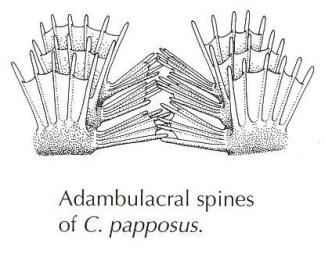Crossaster papposus is a colourful sea star with 8 to 16 arms, usually 10 or 11, up to 8.5 cm long. Its colour is varies greatly: it may be solid purple or red, but it usually has a concentric pattern of bright red, orange, white or yellow on its spiny aboral surface. The ratio of arm to disc ranges from 1.8 to 2.7. The aboral pseudopaxillae are widely spaced and bear up to 50 slender spinelets. The marginals consist of a single series of prominent pseudopaxillae. The oral interradial area has up to about 25 pseudopaxillae. The adambulacrals usually have 3 to 5 furrow spinelets with a transverse comb of 5 to 9 slightly longer stouter spinelets on the oral surface. The mouth plates have 8 to 10 marginal spines with 2 to 4 suborals.
Characteristics
Similar SpeciesCrossaster papposus might be mistaken for a juvenile Pycnopodia helianthoides. But P. helianthoides is generally much larger, has more arms, differs in the detail of the aboral surface, adambulacral and mouth-plate spines and ha
